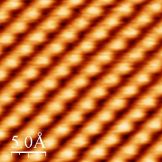Friction and Damping on the Atomic Scale
Friction and damping on the atomic scale
An important goal in surface physics is to understand the phenomena of friction and damping at surfaces. In our experiments, we use the method of dynamic force microscopy (DFM, also frequency modulation atomic force microscopy, FM-AFM), which enables the imaging of conducting, semiconducting and insulating surfaces with atomic resolution. Beside topography, also energy losses at the surface can be recorded.
FM-AFM

A microfabricated silicon cantilever beam with a tip is excited to oscillate with its resonance frequency. When a sample surface is apprached with the cantilever, the forces between tip and sample cause a shift of the resonance frequency. While scanninig the sample surface, a control loop maintains a constant frequency shift by adjusting the distance between tip and sample. The topography of the sample is represented by a surface of coonstant frequency shift.
A second control loop keeps the amplitude of the cantilever constant. The energy that is necessary can be monitored and equals the energy that is lost at the surface. Comparing the signals of topography and energy loss, one can precisely analyze the damping processes.
Torsion mode

In addition to the "normal" oscillation of the cantilever, one can also excite its torsional oscillation. Thus the tip also oscillates parallel to the sample surface. Like in normal mode,one can also monitor the energy loss of the torsional oscillation, giving information on the friction at the surface.
